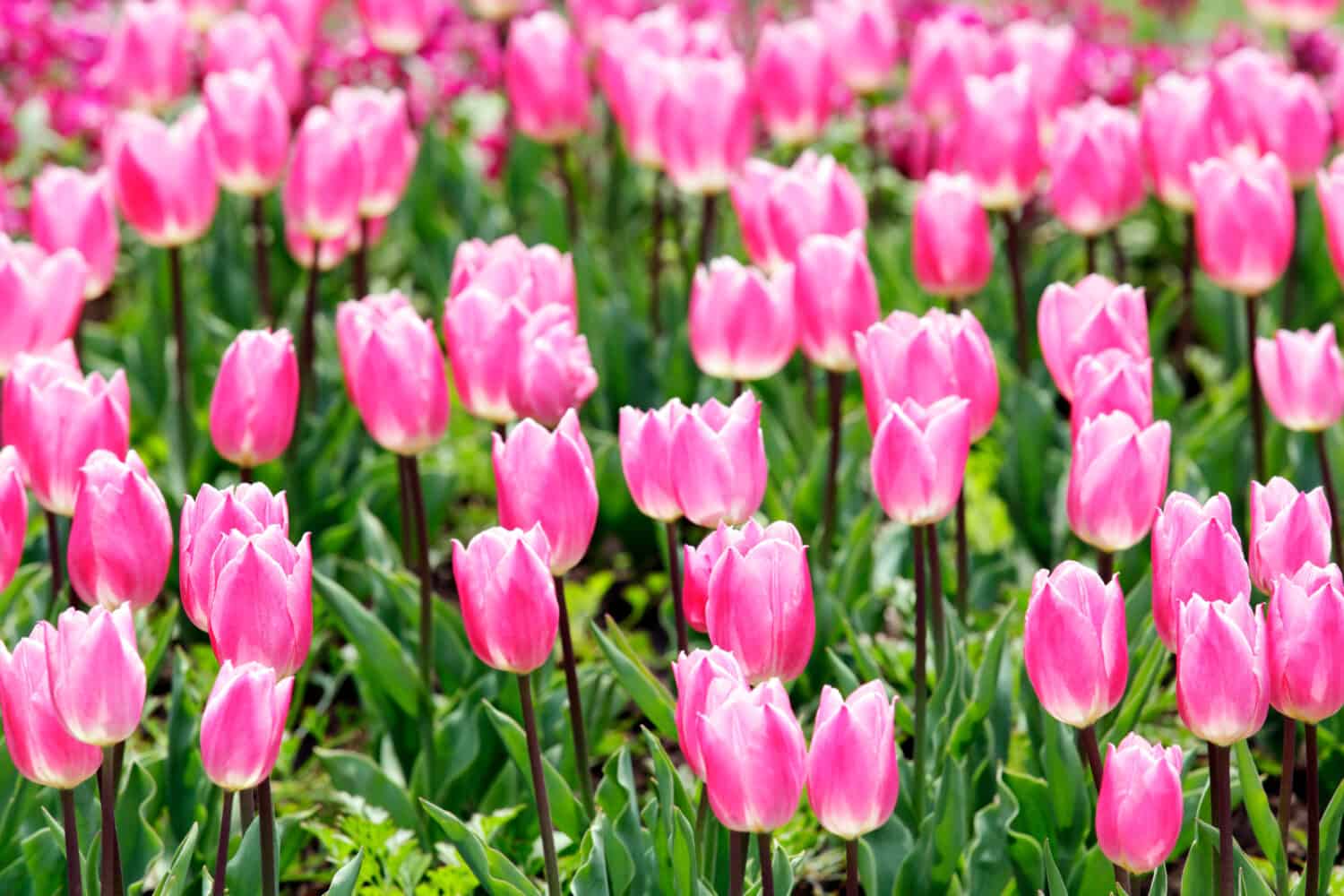New Jersey’s climate is suitable for growing tulips, especially in the northern region of the state. Tulips prefer cool climates with a distinct winter season. They thrive in areas where the temperature during the winter months remains consistently cold. Tulips are spring-blooming bulbs that require a period of cold dormancy in winter to initiate growth and flowering. With its cold winters and well-defined seasons, New Jersey is perfect for a wide range of tulip varieties. Check out the seven most magnificent tulips to grow in New Jersey.
Hardiness Zones
Tulips thrive in USDA Hardiness Zones 3 to 8, although specific varieties may have slightly different preferences. New Jersey is primarily located in USDA Hardiness Zones 6b and 7a. Zone 6b covers most of Northern New Jersey, including cities like Newark, Paterson, and Morristown. It experiences cold winters, with average annual minimum temperatures ranging from -5°F to 0°F (-23.3°C to -17.8°C). Zone 7a includes central and Southern parts of New Jersey, including cities like Trenton, Camden, and Atlantic City. It has slightly milder winters compared to Zone 6b, with average annual minimum temperatures ranging from 0°F to 5°F (-17.8°C to -15°C).
Planting Tips
The best time to plant tulip bulbs in New Jersey is in the fall. Mid-September through the end of October is the most advantageous. Planting then allows the bulb to climate and put out a few roots. Select a sunny location with well-draining soil. Dig a hole that is two to three times the height of the tulip bulb. This generally falls between 6-8 inches (15-20 cm). Place the bulb in the hole with the pointed end facing up, or plant it on its side if unsure. Space the bulbs approximately six inches (15 cm) apart. Cover them with soil, gently firming it down to eliminate air pockets. Water thoroughly, and then sparingly.
1. Artist
Tulipa ‘Artist’ has vibrant and eye-catching blooms. ‘Artist’ tulips display large, elegant flowers with a unique and captivating color combination. One of the more unique tulips, the ‘Artist’ is a beautiful, bold flower with soft green highlights on orange-gold blooms. These intricate patterns create a painterly effect, resembling brushstrokes on a canvas. The contrasting colors make ‘Artist’ tulips stand out in any garden or floral arrangement. ‘Artist’ tulips bloom in mid to late spring. They are part of the single late tulip group, which means they flower later in the tulip season after most other tulip varieties have finished blooming. ‘Artist’ tulips grow 16-20 inches (40-50 cm) tall. ‘Artist’ tulips have strong stems that provide good support for the large flowers, preventing them from drooping or bending easily. The bold colors and mesmerizing patterns make ‘Artist’ a standout choice for those seeking a visually stunning tulip.

One of the more unique tulips, the Artist is a beautiful, bold flower with orange-gold blooms.
©Walter Erhardt/Shutterstock.com
2. Tubergen’s Gem
‘Tubergen’s Gem’ tulips display striking flowers with a combination of yellow and crimson. The petals often have a feathered or flamed pattern, where the crimson gently transitions into yellow toward the edges. ‘Tubergen’s Gem’ grows to a height of 12-16 inches (30-40 cm). A mid-season bloomer, ‘Tubergen’s Gem’ usually flowers in the middle of the tulip blooming period, which typically lands in late April-early May in New Jersey. ‘Tubergen’s Gem’ has sturdy stems and reliable performance. The flowers are long-lasting and maintain their beautiful coloring throughout the blooming period. The overall appearance is elegant and refined, making it a popular choice for gardens and floral arrangements.

‘Tubergen’s Gem’ tulips display striking flowers with a combination of yellow and crimson.
©guentermanaus/Shutterstock.com
3. Angelique
‘Angelique’ tulips produce large, double-flowered blooms with multiple layers of petals. The petals are usually a delicate shade of pink or blush. These beauties could easily be mistaken for roses. The flowers have tightly packed petals forming a lush and full blossom. ‘Angelique’ tulips typically bloom in mid to late spring. They are part of the double late or peony-flowered tulip group, which means they flower later in the tulip season. ‘Angelique’ grows to a height of 16-20 inches (40-50 cm). It is a medium-sized tulip. The stems are strong and sturdy, providing good support for the double blooms. The foliage is green and slender, complementing the soft-colored flowers.
Valued for their visual appeal, ‘Angelique’ tulips add a touch of elegance and softness to floral displays, making them a popular choice for cut flower arrangements and bouquets. ‘Angelique’ blooms are romantic and graceful. ‘Angelique’ tulips are often utilized in floral arrangements for weddings.
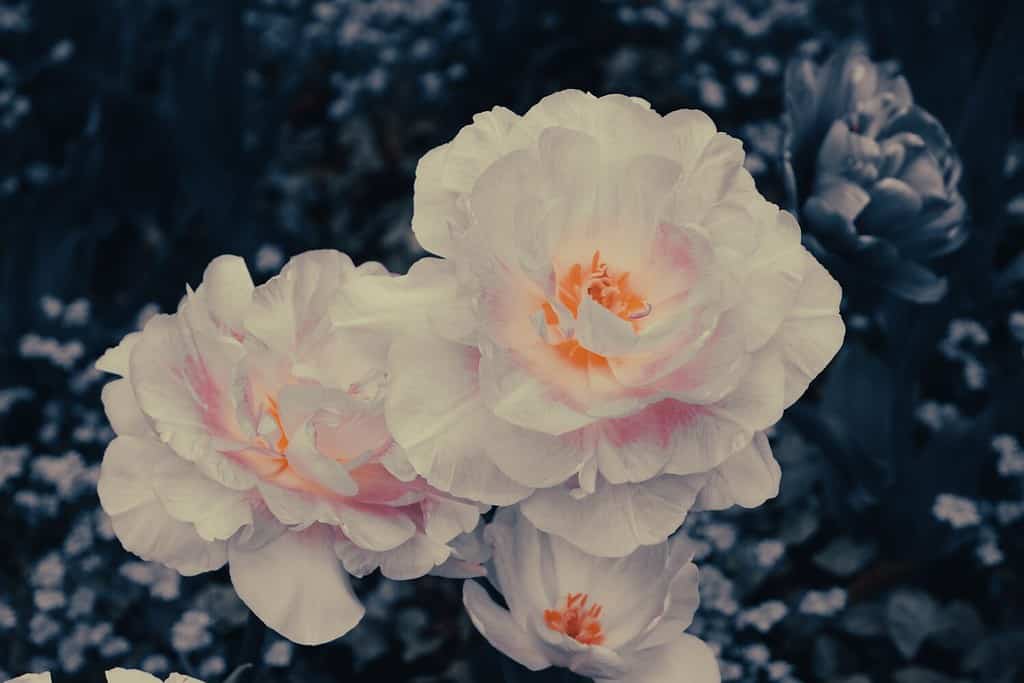
If not for their foliage, ‘Angelique’ tulips couild easily be mistaken for roses.
©Fire-n/Shutterstock.com
4. Biflora
Tulipa biflora, commonly known as the cliff tulip or two-flowered tulip, is a small and charming species of tulip native to the mountainous regions of Central Asia. Tulipa biflora produces petite, bell-shaped flowers with six petals. The flowers are white or yellow, or a combination thereof. Each stem can bear up to two flowers, hence the name biflora.Tulipa biflora blooms in spring, often in April or May. It is an early bloomer, often one of the first tulips to emerge and flower in its native habitat. Tulipa biflora is a relatively short tulip species, growing to a height of between 4 and 8 inches (10 and 20 cm). The slender stems are usually leafless or have narrow leaves that are shorter than the flowering stems. The foliage is green and grass-like in appearance.
Tulipa biflora is native to Central Asia, particularly the mountainous regions of Afghanistan, Tajikistan, and Pakistan. Tulipa biflora grows on rocky slopes, cliffs, or alpine meadows. This species is adapted to colder climates and can tolerate harsh conditions. Tulipa biflora is considered a vulnerable species in the wild due to habitat loss, overgrazing, and collection for the horticultural trade. It is important to source Tulipa biflora bulbs from reputable nurseries that practice responsible, sustainable sourcing and propagation. Tulipa biflora is treasured for its dainty and delicate beauty. While it may not be as commonly cultivated as other tulip varieties, it holds a special place for those who appreciate its natural charm and early spring blooming time.

produces petite, bell-shaped flowers with six petals.
©EvgeniusD/Shutterstock.com
5. Tulip Saxatilis
Tulipa saxatilis, commonly known as the wild tulip or rock tulip, is charming and delicate. It is native to regions of Southeastern Europe and Southwestern Asia. The flowers of Tulipa saxatilis are small to medium-sized, typically measuring 2 inches (5 cm) in diameter. They have six pointed petals that open wide to reveal a beautiful cup-shaped bloom. The petals can vary in color, ranging from pale pink and lavender. The inner base of the petals often features a contrasting yellow center. Tulipa saxatilis is an early bloomer, often flowering in early to mid-spring. Its blooms emerge before many other tulip varieties, adding a splash of color to the garden early in the season. Tulipa saxatilis grows to a height of between 6-10 inches (15-25 cm). It forms clumps of slender, grass-like foliage that emerge in early spring. After the flowers fade, the foliage remains green for a while before withering.
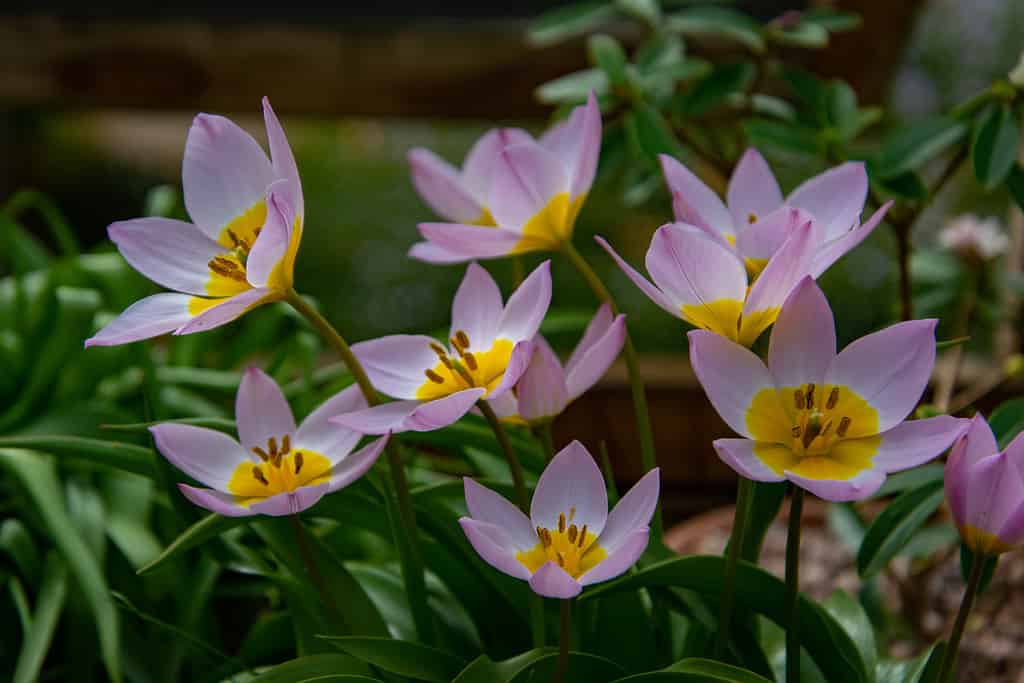
The flowers of
Tulipa saxatilisare small to medium-sized, typically measuring 2 inches (5 cm) in diameter.
©NKHPhotography/Shutterstock.com
6. Queen of the Night
Tulipa ‘Queen of the Night’ is valued for its rich, velvety, dark-purple-to-almost-black blooms.
‘Queen of the Night’ features large, goblet-shaped flowers with smooth, dark-colored petals. The-deep purple-to-nearly-black petals create a dramatic and striking contrast in the garden. ‘Queen of the Night’ tulips are late bloomers. They are part of the late-season tulip group, which extends the tulip blooming season through the end of spring. ‘Queen of the Night’ typically grows to a height of 20-24 inches (50-60 cm), making it a medium-tall tulip. The stems are strong and sturdy, supporting the large and heavy flowers. The foliage is green and slender, providing an attractive backdrop to the dark blooms. The dark and dramatic flowers of the ‘Queen of the Night’ tulip are often paired with lighter-colored tulips or other spring flowers to create visually stunning combinations.
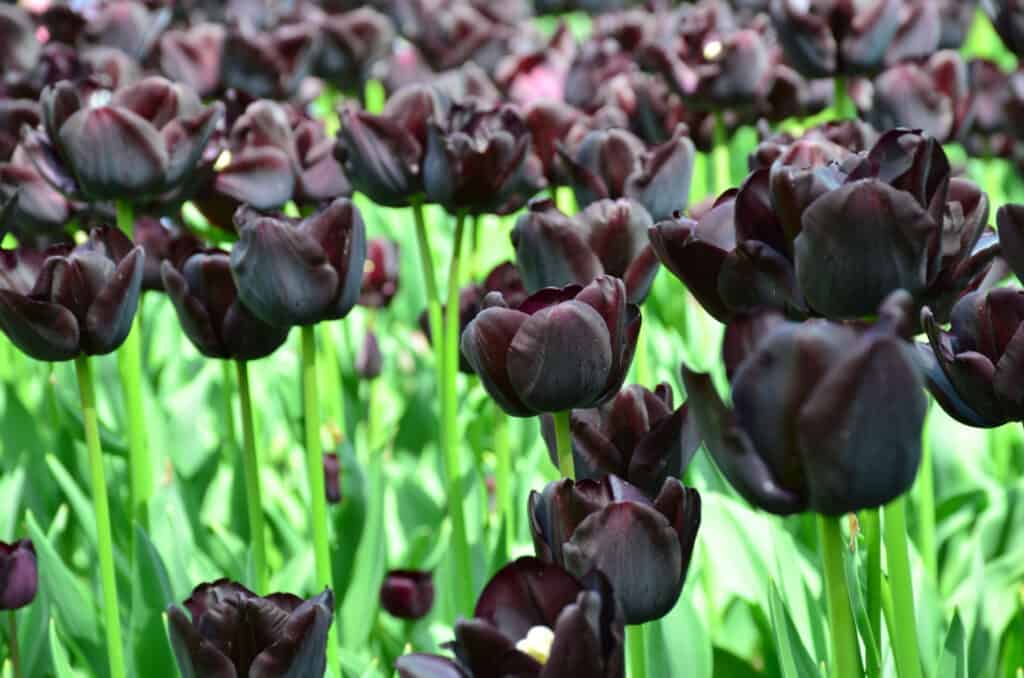
Tulipa ‘Queen of the Night’ is valued for its rich, velvety, dark-purple-to-almost-black blooms.
©rob3rt82/Shutterstock.com
7. Maureen
Tulipa ‘Maureen’ is a beautiful and popular tulip variety known for its elegant and pristine white blooms. These make a striking contrast to ‘Queen of the Night.’ ‘Maureen’ tulips produce large, cup-shaped flowers with creamy white petals. The blooms are usually single-flowered, meaning they have a single row of petals. The petals are slightly pointed and often have a subtle sheen, adding to their overall allure. The white color of ‘Maureen’ tulips is pure and bright, creating a stunning visual impact in the garden.
‘Maureen’ tulips bloom in mid-to-late spring. They are part of the mid-season tulip group, blooming after the early spring varieties but before the late spring or parrot tulips. This timing makes them a great addition to extend the tulip flowering period in gardens. ‘Maureen’ tulips grow 16-20 inches (40-50 cm). ‘Maureen’ tulips have strong and sturdy stems that support the large flowers, preventing them from drooping or bending easily. The foliage is green and slender, complementing the showy white flowers.
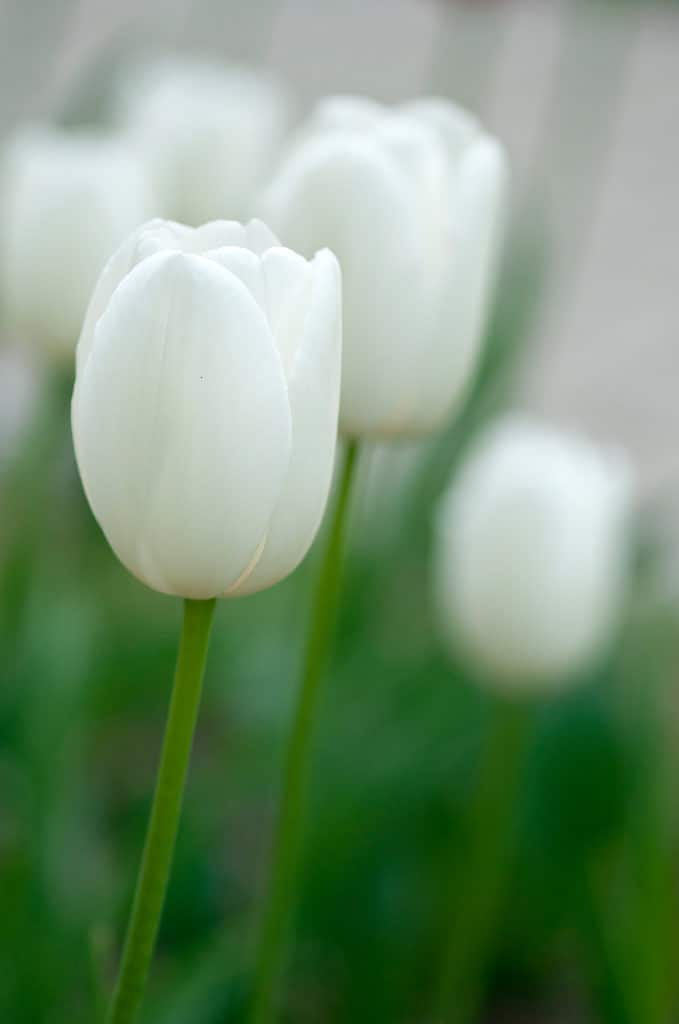
‘Maureen’ tulips produce large, cup-shaped flowers with creamy white petals.
©Liviu Gherman/Shutterstock.com
Thank you for reading! Have some feedback for us? Contact the AZ Animals editorial team.

